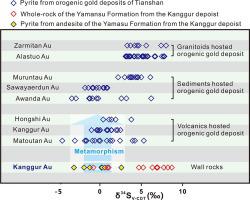当前位置:
X-MOL 学术
›
Ore Geol. Rev.
›
论文详情
Our official English website, www.x-mol.net, welcomes your
feedback! (Note: you will need to create a separate account there.)
Geochronology, geochemistry, and Sr–Nd–Pb–Hf–S isotopes of the wall rocks of the Kanggur gold polymetallic deposit, Chinese North Tianshan: Implications for petrogenesis and sources of ore-forming materials
Ore Geology Reviews ( IF 3.2 ) Pub Date : 2020-10-01 , DOI: 10.1016/j.oregeorev.2020.103688 M.N. Muhtar , Chang-Zhi Wu , Matthew J. Brzozowski , Ping Li , Xiu-Cai Yuan , Si-Meng Wang , Jun Zhi , Yao-Hui Jiang
Ore Geology Reviews ( IF 3.2 ) Pub Date : 2020-10-01 , DOI: 10.1016/j.oregeorev.2020.103688 M.N. Muhtar , Chang-Zhi Wu , Matthew J. Brzozowski , Ping Li , Xiu-Cai Yuan , Si-Meng Wang , Jun Zhi , Yao-Hui Jiang

|
Abstract The Kanggur gold polymetallic deposit, located in the western segment of the Kanggur–Huangshan Shear Zone (KHSZ) of the Chinese North Tianshan, is the largest shear zone-controlled gold polymetallic deposit in this region. The gold mineralization is hosted by Early Carboniferous volcanic rocks of the Yamansu Formation, which is predominantly composed of andesite, dacite, and tuff. In this contribution, we present U–Pb age data and Hf isotopes of zircon from wall rocks associated with mineralization in the Kanggur deposit, as well as whole-rock geochemistry of the wall rocks with the goal of characterizing the petrogenesis of the deposit, and the sources of the ore-forming materials. Our new LA–ICP–MS zircon age data indicate that the wall rocks formed at ca. 340 Ma in the Early Carboniferous (andesite at 338.0 ± 1.7 Ma, dacite at 338.1 ± 2.2 Ma, rhyolite 332.4 ± 2.8 Ma, and granite porphyry at 342.6 ± 1.9 Ma). These wall rocks are enriched in light rare earth elements (LREEs) and large ion lithophile elements (LILEs; e.g., U, K, and Pb), and depleted in high field strength elements (HFSEs; e.g., Nb, Ta, and Ti). Based on the lack of ancient crustal basement rocks in the Qoltag Arc, the lithological assemblage of andesite–dacite–rhyolite, the presence of chert, and the enrichment of andesite and dacite in Na2O (3.35–6.89 wt%) relative to K2O (0.67–2.42 wt%), it is inferred that the Early Carboniferous volcanic wall rocks of the deposit formed in an oceanic arc setting. Considering the similar isotopic compositions of andesite, dacite, rhyolite, and granite porphyry (eNd (t) = −0.12 to 0.64 and eHf(t) = 6.05 to 8.96 for andesite, eNd(t) = 1.01 to 3.02 for dacite; eNd(t) = 4.20 to 4.91 and eHf(t) = 11.02 to 13.79 for rhyolite, and eNd(t) = 1.65 to 2.13 and eHf(t) = 4.70 to 6.80 for granite porphyry) and juvenile Hf model ages (TDM1 = 610 to 730 Ma for andesite, TDM2 = 460 to 640 Ma for rhyolite, and TDM2 = 910 to 1050 for granite porphyry), it is suggested that the primary magma from which the andesite and dacite crystallized was derived from partial melting of metasomatized mantle wedge, whereas, the magma from which the rhyolite and granite porphyry crystallized was derived from partial melting of juvenile lower crust. The bulk S isotope composition (δ34SV-CDT) of these wall rocks varies from −0.8 to 8.7‰ (average of 4.8‰), with the S isotope composition of the andesite and rhyolite being similar to that of pyrite in mineralized rock. The bulk Pb isotope composition of these wall rocks ranges from 17.561 to 18.258 206Pb/204Pb, 15.535 to 15.602 207Pb/204Pb, and 37.593 to 38.118 208Pb/204Pb, with the Pb isotope composition of andesite being similar to that of pyrite from gold-bearing ores in the Kanggur deposit. The high abundance of sulfides in the wall rocks, and the similar S–Pb isotope compositions of ores and andesite suggests that the ore-forming materials were likely derived from the andesite wall rocks.
更新日期:2020-10-01









































 京公网安备 11010802027423号
京公网安备 11010802027423号